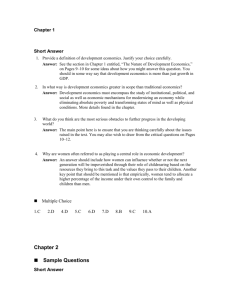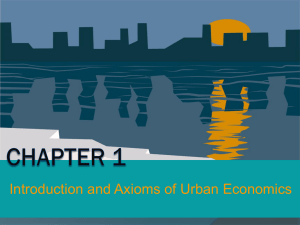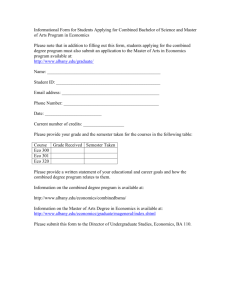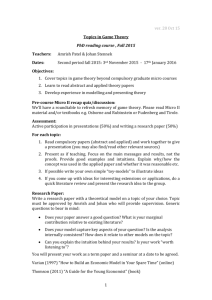1 - UC San Diego Department of Economics
advertisement
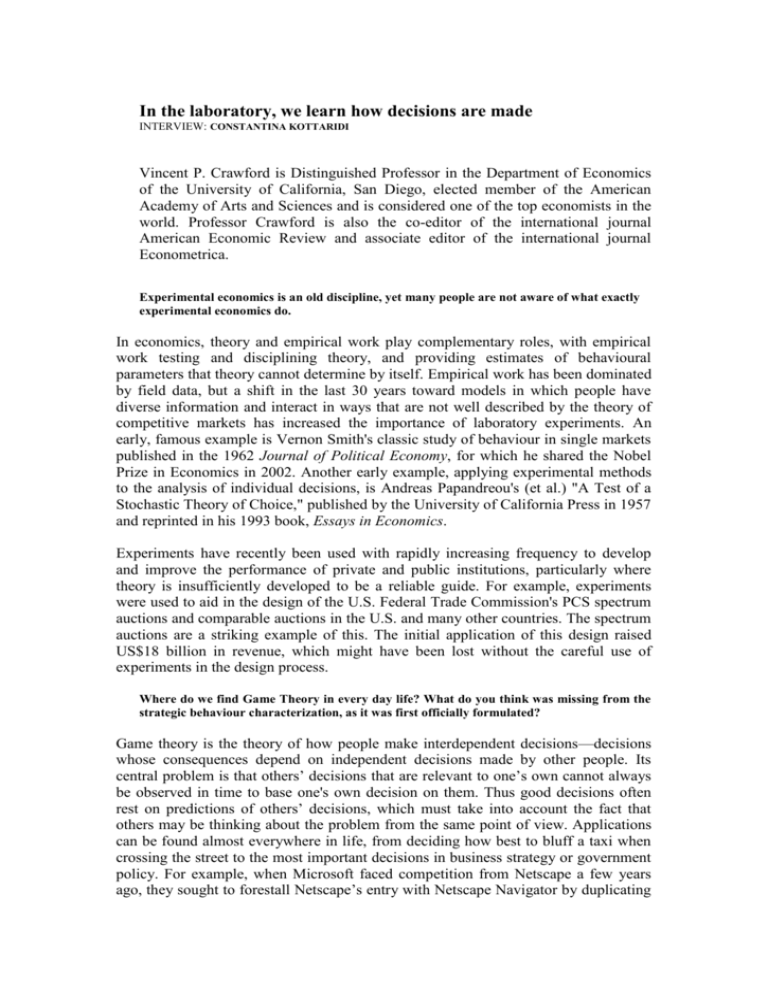
In the laboratory, we learn how decisions are made INTERVIEW: CONSTANTINA KOTTARIDI Vincent P. Crawford is Distinguished Professor in the Department of Economics of the University of California, San Diego, elected member of the American Academy of Arts and Sciences and is considered one of the top economists in the world. Professor Crawford is also the co-editor of the international journal American Economic Review and associate editor of the international journal Econometrica. Experimental economics is an old discipline, yet many people are not aware of what exactly experimental economics do. In economics, theory and empirical work play complementary roles, with empirical work testing and disciplining theory, and providing estimates of behavioural parameters that theory cannot determine by itself. Empirical work has been dominated by field data, but a shift in the last 30 years toward models in which people have diverse information and interact in ways that are not well described by the theory of competitive markets has increased the importance of laboratory experiments. An early, famous example is Vernon Smith's classic study of behaviour in single markets published in the 1962 Journal of Political Economy, for which he shared the Nobel Prize in Economics in 2002. Another early example, applying experimental methods to the analysis of individual decisions, is Andreas Papandreou's (et al.) "A Test of a Stochastic Theory of Choice," published by the University of California Press in 1957 and reprinted in his 1993 book, Essays in Economics. Experiments have recently been used with rapidly increasing frequency to develop and improve the performance of private and public institutions, particularly where theory is insufficiently developed to be a reliable guide. For example, experiments were used to aid in the design of the U.S. Federal Trade Commission's PCS spectrum auctions and comparable auctions in the U.S. and many other countries. The spectrum auctions are a striking example of this. The initial application of this design raised US$18 billion in revenue, which might have been lost without the careful use of experiments in the design process. Where do we find Game Theory in every day life? What do you think was missing from the strategic behaviour characterization, as it was first officially formulated? Game theory is the theory of how people make interdependent decisions—decisions whose consequences depend on independent decisions made by other people. Its central problem is that others’ decisions that are relevant to one’s own cannot always be observed in time to base one's own decision on them. Thus good decisions often rest on predictions of others’ decisions, which must take into account the fact that others may be thinking about the problem from the same point of view. Applications can be found almost everywhere in life, from deciding how best to bluff a taxi when crossing the street to the most important decisions in business strategy or government policy. For example, when Microsoft faced competition from Netscape a few years ago, they sought to forestall Netscape’s entry with Netscape Navigator by duplicating the browser’s features in their own Internet Explorer program. Both developments proceeded simultaneously, so both companies’ programmers had to make educated guesses about the features the other’s program would have. Understanding how they decided what to do therefore requires a game-theoretic analysis. Traditional game theory uses the notion of Nash equilibrium—named for John Nash, who shared the Economics Nobel Prize in 1994 and received an honorary doctorate from the University of Athens in 2000—in which each decision maker makes a decision that is best for him, given his own goals and others' decisions. Implicitly, equilibrium assumes that each person has a perfect model of others’ decisions, which makes predictions that are at least statistically correct, as in the notion of rational expectations equilibrium in macroeconomics. Equilibrium is a powerful and useful tool in situations where people have a lot of previous experience with analogous games. You are the Director of the Economics EXperimental and Computational Laboratory (EEXCL) in the University of California, San Diego. What do you do in the Laboratory? My recent work is in a branch of game theory called behavioral game theory, which combines theory with empirical—mostly experimental—evidence about strategic behavior to produce a more general and more useful theory. A major part of this work uses laboratory experiments to gather empirical evidence that better reveals the structure of peoples’ decisions. In our laboratory (with capacity of 18-24 subjects), subjects are brought together to make decisions in a specific, precisely described environment. What is the outcome of experiments carried out in your Laboratory as to the behaviour and strategic thinking of 'real' people? In collaboration with my former student Miguel Costa-Gomes, now at the University of York in the U.K., I have designed and run experiments that reveal with great precision how people predict each others’ responses to novel situations. We have found that the part of their responses is not well described by equilibrium. When it comes to more complex games, peoples' decisions deviate systematically from equilibrium. We have developed a model originally proposed by others, called the level-k model, which both predicts when peoples' decisions will conform to equilibrium and predicts how they will deviate when they do. Would you say that experimental economics and experimental game theory in your particular case are more important than the theories themselves? Yes, in the sense that they are tools, which (much like econometrics) could change all of economics, beyond the fields in which they were first used. In what way the level-k-thinking extends Game Theory In his recent lecture in the Department of Economics at the University of Peloponnese Professor Crawford talked about the level-k-model. We asked him in what way the level-k-model extends game theory and what the implications of it are. The level-k model generalizes equilibrium to provide a better description of peoples’ initial responses to a wider variety of situations. We have been using it both to analyze the data from our experiments, and to address puzzles in economics and social science that resist analysis via equilibrium. Consider the quotation regarding the poisoning of Ukrainian presidential candidate (now president) Viktor Yushchenko with which the paper begins, "Any government wanting to kill an opponent…would not try it at a meeting with government officials." This argument reflects a common strategic intuition that is inconsistent with equilibrium: if the investigators were expected to think that way, a meeting with government officials would be exactly where a government would try to kill an opponent. Our analysis shows that the level-k model both explains the strategic thinking behind the quotation and shows how the best way to poison Yuschenko—or more importantly, to catch the poisoners—is determined by notions of strategic behavior like those the quotation expresses. Another example of how the level-k model can improve upon equilibrium is the analysis of the World War II Allies' decision whether to invade Europe on D-Day at Normandy or Calais, and their associated attempts to deceive the Germans about where the invasion would be, in my 2003 paper in the American Economic Review. A final example of level-k-style thinking in business comes from Benjamin Graham (of Graham and Dodd's Security Analysis), in The Intelligent Investor:


